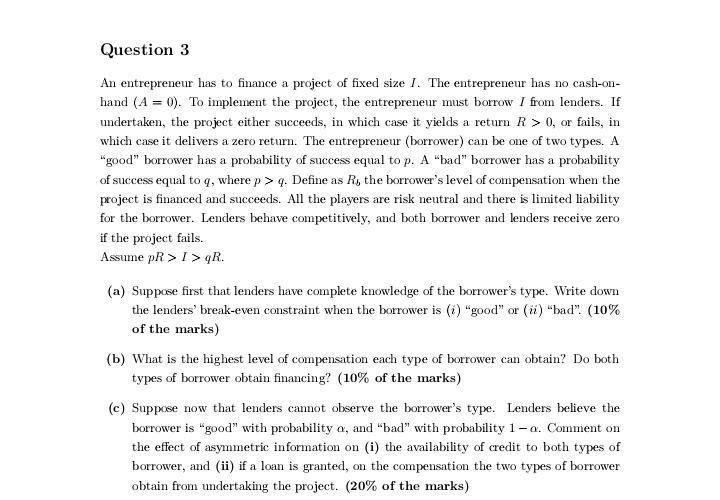
Question 3 An entrepreneur has to finance a project of fixed size 1. The entrepreneur has no cash-on- hand (A = 0). To implement the project, the entrepreneur must borrow 1 from lenders. If undertaken, the project either succeeds, in which case it yields a return R > 0, or fails, in which case it delivers a zero return. The entrepreneur (borrower) can be one of two types. A "good" borrower has a probability of success equal to p. A "bad" borrower has a probability of success equal to q, where p > 4. Define as R, the borrower's level of compensation when the project is financed and succeeds. All the players are risk neutral and there is limited liability for the borrower. Lenders behave competitively, and both borrower and lenders receive zero if the project fails. Assume pR > I > GR. (a) Suppose first that lenders have complete knowledge of the borrower's type. Write down the lenders' break-even constraint when the borrower is (1) "good" or () "bad". (10% of the marks) (b) What is the highest level of compensation each type of borrower can obtain? Do both types of borrower obtain financing? (10% of the marks) (c) Suppose now that lenders cannot observe the borrower's type. Lenders believe the borrower is "good" with probability a, and "bad" with probability 1-a. Comment on the effect of asymmetric information on (i) the availability of credit to both types of borrower, and (ii) if a loan is granted, on the compensation the two types of borrower obtain from undertaking the project. (20% of the marks) Question 3 An entrepreneur has to finance a project of fixed size 1. The entrepreneur has no cash-on- hand (A = 0). To implement the project, the entrepreneur must borrow 1 from lenders. If undertaken, the project either succeeds, in which case it yields a return R > 0, or fails, in which case it delivers a zero return. The entrepreneur (borrower) can be one of two types. A "good" borrower has a probability of success equal to p. A "bad" borrower has a probability of success equal to q, where p > 4. Define as R, the borrower's level of compensation when the project is financed and succeeds. All the players are risk neutral and there is limited liability for the borrower. Lenders behave competitively, and both borrower and lenders receive zero if the project fails. Assume pR > I > GR. (a) Suppose first that lenders have complete knowledge of the borrower's type. Write down the lenders' break-even constraint when the borrower is (1) "good" or () "bad". (10% of the marks) (b) What is the highest level of compensation each type of borrower can obtain? Do both types of borrower obtain financing? (10% of the marks) (c) Suppose now that lenders cannot observe the borrower's type. Lenders believe the borrower is "good" with probability a, and "bad" with probability 1-a. Comment on the effect of asymmetric information on (i) the availability of credit to both types of borrower, and (ii) if a loan is granted, on the compensation the two types of borrower obtain from undertaking the project. (20% of the marks)







